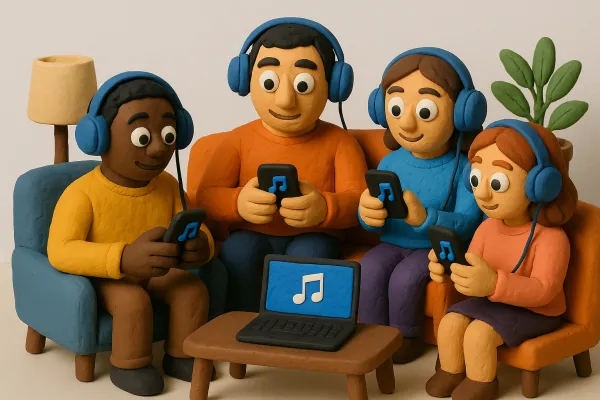Understanding How Much Per Stream: A Comprehensive 2025 Guide for Artists

If you've ever been curious about how much artists earn from streaming their music, you're not alone. With platforms like Spotify, Apple Music, and YouTube taking over how we listen to songs, many people wonder what portion of the revenue actually reaches the musicians behind the tracks. In this guide, we'll break down the numbers, the processes involved, and what they mean for artists trying to make a living in today's music landscape.
Key Takeaways
- Streaming royalties are typically just a fraction of a cent per stream, making it tough for artists to earn a living solely from streaming.
- Different platforms have varying payout rates; for example, Spotify pays around $0.003 to $0.005 per stream, while Apple Music pays about $0.01.
- Factors such as subscription type, listener location, and record label agreements can significantly influence how much an artist earns per stream.
- To make a decent income from streaming, artists often need hundreds of thousands of streams each month, which is a challenge for many independent musicians.
- Exploring alternative revenue streams like merchandise, live performances, and fan support can help artists supplement their income beyond streaming.
Understanding Streaming Royalties
What Are Streaming Royalties?
Okay, let's talk about streaming royalties. It's how we, as artists, get paid when people listen to our music on platforms like Spotify, Apple Music, and YouTube. Think of it as a tiny fraction of a penny for every play, which adds up (hopefully!) over time. It's not like the old days of selling CDs, but it's the main way many of us are earning money now. Understanding music royalties is super important for any musician trying to make a living in today's digital world.
How Do Streaming Royalties Work?
So, how does this whole streaming royalty thing actually work? Well, when someone streams our song, the platform collects revenue from subscriptions and ads. Then, they distribute a portion of that revenue as royalties. But here's the catch: it's not a simple calculation. There are a bunch of factors that go into it, like:
- The platform's payout rate (which varies).
- Where the listener is located (some countries pay more).
- Whether the listener has a premium subscription or is using a free account.
It's a bit of a black box, to be honest. The platforms don't always make it easy to see exactly how the money is being divided, and the rates can change without much warning. It's important to keep track of your streams and revenue, and to understand the terms of your distribution agreements.
Why Do Artists Get Paid So Little?
This is the million-dollar question, right? Why are we seeing fractions of a penny per stream? Well, there are a few reasons. First, the revenue from streaming is split between a lot of different parties: the platform, the record label (if you have one), the publisher, the songwriter, and finally, the artist. Second, the overall pie is still relatively small compared to the old days of music sales. While streaming is huge, it doesn't generate as much revenue per listen as buying a CD or a digital download did. It's a tough situation, and it's why many artists are looking for alternative revenue streams to supplement their income.
Breaking Down Payouts By Platform
It's tough to give exact numbers, but let's break down what you can generally expect from the major streaming platforms. Keep in mind these are averages, and your actual earnings can vary quite a bit.
Spotify's Payout Structure
Spotify is the big player, so understanding their system is key. Spotify's payout per stream usually falls somewhere between $0.003 and $0.005. This means you need a whole lot of streams to make any real money. The exact amount depends on a bunch of things, like where your listeners are located and whether they have premium accounts. Spotify compensates artists using a pro-rata system, where the total revenue is divided based on the share of total streams.
Apple Music's Earnings
Apple Music tends to pay a bit better than Spotify. They don't have a free tier supported by ads, which means more money to go around. You can generally expect around $0.006 to $0.01 per stream. It might not sound like much, but it adds up, especially if you can get your music on popular playlists. Apple Music operates primarily on a subscription-based model, which allows for a more straightforward revenue distribution.
YouTube's Revenue Model
YouTube is a whole different beast. While it can bring in a lot of views, the payout per view is generally much lower than dedicated music streaming services. We're talking fractions of a cent – somewhere around $0.00067 to $0.00139 per view. However, YouTube offers other ways to make money, like through ads on your videos and YouTube Premium subscriptions. If ads are displayed on videos featuring an artist’s music, they earn a share of the ad revenue.
It's important to remember that these numbers are just averages. Your actual earnings will depend on a variety of factors, including your location, your audience, and your agreements with distributors and labels. Don't get discouraged if your first few payouts are small. Keep creating, keep promoting, and keep learning about the industry.
Factors That Influence How Much Per Stream
It's not a simple calculation to figure out how much you'll make per stream. Lots of things are in play. Let's break down some of the big ones.
The Role of Subscription Types
Okay, so here's the deal: streams from paid subscribers are worth way more than streams from free users. Think about it – premium users are directly putting money into the streaming service's pocket each month. Free users? They're just watching ads, and that revenue is split a million different ways. So, if a bunch of your listeners are on the free tier, don't expect huge payouts. It's just how it works.
- Premium streams generate more revenue.
- Ad-supported streams generate less revenue.
- The ratio of premium to free listeners impacts overall earnings.
Geographic Variations in Payouts
Where your listeners are located seriously impacts your earnings. A stream in the US or UK, where subscription fees are higher, is worth more than a stream in a country with lower fees. It's all about the money coming into the platform in that region. The actual earnings of artists are affected by this.
Basically, the more money a streaming service makes in a particular country, the more they can pay out per stream in that country. Makes sense, right?
Impact of Record Label Agreements
If you're signed to a record label, they're going to take a cut – sometimes a big one. That's just part of the deal. The specifics depend on your contract, but it's safe to say you won't be seeing all, or even most, of the revenue generated by your music. If you're independent, you get to keep a much larger share, which is a definite plus.
- Labels take a percentage of streaming royalties.
- The percentage varies based on the contract.
- Independent artists retain more of their earnings.
How Many Streams Do You Need to Make a Living?
Calculating Monthly Income Goals
Okay, let's get real. How much do you actually need to make each month to, you know, live? Rent, food, bills – it all adds up. Before we even think about streams, we need a target. Is it $1,000 a month? $3,000? More? This number is our starting point. Once we know that, we can start figuring out how many streams we need to get there. Don't forget to factor in taxes and any other expenses related to your music career, like equipment or marketing. It's easy to overlook those, but they definitely impact your bottom line.
Realistic Streaming Targets
Alright, so you know your monthly goal. Now, let's talk numbers. Streaming payouts vary wildly. Spotify might pay one rate, while Apple Music pays another. And YouTube? Forget about it (kidding...sort of). To get a rough idea, let's say the average payout is around $0.004 per stream. To make $1,000, you'd need 250,000 streams. Sounds like a lot, right? It is! But don't get discouraged. It's about setting achievable milestones and steadily building your audience. Use a Spotify royalty calculator to get a better idea of potential earnings.
The Challenge for Independent Artists
Here's the thing: making a living from streaming alone is tough, especially if you're an independent artist. You're not just competing with other indie musicians; you're up against major label artists with huge marketing budgets. Plus, if you're signed to a label, they take a cut – sometimes a big one.
It's a grind. Building a fanbase takes time and effort. You need to be consistent with your releases, engage with your fans, and promote your music like crazy. Don't expect to get rich overnight. It's a marathon, not a sprint.
Here are some things to keep in mind:
- Promotion is key: Share your music everywhere. Social media, playlists, blogs – get your name out there.
- Engage with fans: Respond to comments, do live streams, make personal connections.
- Don't give up: It takes time to build momentum. Keep creating, keep promoting, and keep pushing forward.
Remember, streaming is just one piece of the puzzle. We'll talk about other revenue streams later, but for now, focus on setting realistic goals and building a solid foundation.
Alternative Revenue Streams for Musicians
Streaming is cool and all, but let's be real, it's tough to make a decent living off it alone. We need to think beyond just streams if we want to keep creating music. Luckily, there are other ways to bring in some cash.
Merchandise Sales
Selling merch is a classic for a reason. Fans love to support artists by buying things like t-shirts, hoodies, posters, and even physical copies of albums. It's a direct way for them to show their love, and it puts money directly in our pockets. Think about cool designs that represent your music and brand. You can sell merch at shows, on your website, or through platforms like Shopify or Bandcamp.
Live Performances
Nothing beats the energy of a live show. Concerts and tours are where we can really connect with our fans and make some serious money. Streaming is great, but live shows offer an experience that people are willing to pay for. Plus, you can sell merch at your shows, creating a double revenue stream. Start small, play local gigs, and gradually work your way up to bigger venues and tours. Don't forget to factor in expenses like travel, venue rental, and paying your bandmates.
Crowdfunding and Fan Support
Crowdfunding platforms like Patreon and Kickstarter are game-changers. They allow fans to directly support us through monthly subscriptions or one-time donations. Patreon is especially great for building a community and offering exclusive content to your supporters. Think about offering things like early access to new music, behind-the-scenes videos, or even personalized songs. It's all about building a strong relationship with your fans and giving them a way to support your work directly. Consider using fan support platforms to build a sustainable income.
Relying solely on streaming income can be a real struggle. Diversifying our income streams is key to surviving and thriving in the music industry. Think of streaming as just one piece of the puzzle, and explore all the other options available to us.
The Future of Streaming Royalties
Potential Changes in Payout Models
Okay, so streaming isn't going anywhere, right? But the way artists get paid? That's definitely up for grabs. We're seeing some platforms test out new ways to calculate royalties, trying to make things a bit fairer. Imagine a world where your fan base directly impacts your earnings – that's the kind of stuff being thrown around. It's all about finding a system that actually values the artist, not just the stream count.
Emerging Platforms and Their Impact
It's not just Spotify and Apple Music anymore. New platforms are popping up all the time, each with its own take on how to pay artists. Some are focused on blockchain tech, others on direct fan support. These new players could shake things up, forcing the big guys to rethink their models. Plus, different platforms attract different audiences, which can affect streaming passive income based on who's listening and where they're located.
Artist Advocacy for Fair Compensation
We're not just sitting around waiting for the platforms to change things. Artists are getting organized, pushing for better deals and more transparency. It's about demanding a seat at the table and making sure our voices are heard. Whether it's through unions, advocacy groups, or just good old-fashioned social media campaigns, we're fighting for a system that actually works for the people making the music.
The future of streaming royalties isn't set in stone. It's something we're actively shaping, and it's going to take all of us – artists, fans, and platforms – to build a system that's sustainable and fair for everyone involved. It's a long road, but we're in it for the long haul.
As we look ahead, the way artists earn money from streaming is changing fast. New ideas are popping up to make sure musicians get paid fairly for their work. If you want to learn more about how these changes could affect your favorite artists, visit our website for the latest updates and insights!
Wrapping It Up
So, there you have it! Figuring out how much artists make per stream is a bit of a puzzle, right? It really depends on a bunch of things like the platform, where the listeners are, and if the artist is signed to a label. While streaming is a great way to get your music out there, it’s clear that most artists can’t just live off those tiny payouts. If you love an artist, consider supporting them in other ways too—like buying merch or going to their shows. At the end of the day, understanding this stuff helps us all appreciate the hard work that goes into the music we enjoy.
Frequently Asked Questions
How much do artists make for each stream?
Artists earn different amounts depending on the platform. For example, Spotify pays about $0.003 to $0.005 per stream, while Apple Music pays about $0.01 per stream.
What factors affect streaming royalties?
Several things can change how much artists earn. This includes the streaming platform being used, where the listener is located, whether the listener is a paid subscriber or using a free account, and any agreements with record labels.
Why do artists seem to earn so little from streaming?
Streaming services use a system where all earnings are pooled and shared among all artists. This means popular artists get a bigger share, leaving less for smaller or independent artists.
How many streams do I need to make a living as an artist?
If an artist wants to earn $1,000 a month from streaming, they would need about 250,000 streams on Spotify, which can be very hard to achieve.
What other ways can artists earn money besides streaming?
Artists can make money through selling merchandise, performing live concerts, and getting support from fans through platforms like Patreon.
What changes might happen in streaming royalties in the future?
The way streaming royalties are calculated may change. Some platforms are looking for new ways to make payouts fairer for artists, and artists are advocating for better compensation.





